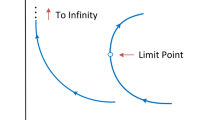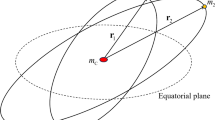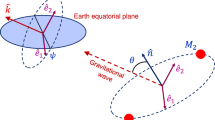Abstract
The aim of this paper is to understand the common characteristics of the generalized flyby trajectory around natural elongated bodies. Such flyby trajectories provide a short-term mechanism to clear away vicinal objects or temporally capture ejecta into circling orbits. The gravitational potential of elongated bodies is described by a unified approximate model, i.e., the rotating mass dipole which is two point masses connected with a constant massless rod. The energy power is used to illustrate the flyby effect in terms of the instantaneous orbital energy. The essential of the single flyby trajectory is studied analytically, and the relationship between the flyby trajectory and its Jacobi integral is also illustrated. Sample trajectories are given to show the variational trend of the energy increment with respect to different orbital periapsides. The distribution of natural ejecting orbits is presented by varying the parameters of the approximate model.









Similar content being viewed by others
References
Baoyin, H.X., Li, J.F.: A survey on orbital dynamics and navigation of asteroid missions. Acta Mech. Sin. 30, 282–293 (2014)
Scheeres, D.J., Ostra, S.J., Hudson, R.S., et al.: Orbits close to asteroid 4769 Castalia. ICARUS 121, 67–87 (1996)
Jiang, F.H., Baoyin, H.X., Li, J.F.: Practical techniques for low-thrust trajectory optimization with homotopic approach. J. Guid. Control Dyn. 35, 245–258 (2012)
Yu, Y., Baoyin, H.X.: Resonant orbits in the vicinity of asteroid 216 Kleopatra. Astrophys. Space Sci. 343, 75–82 (2013)
Wang, X.Y., Gong, S.P., Li, J.F.: A method for classifying orbits near asteroids. Acta Mech. Sin. 30, 316–325 (2014)
Xu, M., Xu, S.J.: Exploration of distant retrograde orbits around Moon. Acta Astronaut. 65, 853–860 (2009)
Tricarico, P., Sykes, M.V.: The dynamical environment of dawn at Vesta. Planet. Space Sci. 58, 12–38 (2010)
Scheeres, D.J., Williams, B.G., Miller, J.K.: Evaluation of the dynamic environment of an asteroid: applications to 433 Eros. J. Guid. Control Dyn. 23, 466–475 (2000)
Scheeres, D.J.: Dynamics about uniformly rotating triaxial ellipsoids: applications to asteroids. Icarus 110, 225–238 (1994)
Elipe, A., Lara, M.: A Simple model for the chaotic motion around (433) Eros. In: AAS 03-563. AAS/AIAA Astrodynamics Specialists Conference, Big Sky, Montana, 1–15 (2003)
Bartczak, P., Breiter, S.: Double material segment as the model of irregular bodies. Celest. Mech. Dyn. Astron. 86, 131–141 (2003)
Prieto-Llanos, T., Gómez-Tierno, M.A.: Stationkeeping at libration points of natural elongated bodies. J. Guid. Control Dyn. 17, 787–794 (1994)
Liu, X.D., Baoyin, H.X., Ma, X.R.: Periodic orbits in the gravity field of a fixed homogenous cube. Astrophys. Space Sci. 334, 357–364 (2011)
Blesa, F.: Periodic orbits around simple shaped bodies. In: Ninth international conference Zaragoza-Pau on applied mathematics and statistics: Jaca (Spain), September 19–21, 2005, 67–74. Seminario Matemático “García de Galdeano” (2006). (in Spanish)
Li, X.Y., Qiao, D., Cui, P.Y.: The equilibria and periodic orbits around a dumbbell-shaped body. Astrophys. Space Sci. 348, 417–426 (2013)
Zeng, X.Y., Jiang, F.H., Li, J.F., et al.: Study on the connection between the rotating mass dipole and natural elongated bodies. Astrophys. Space Sci. 356, 29–42 (2015)
Yang, H.W., Zeng, X.Y., Baoyin, H.X.: Feasible region and stability analysis for hovering around elongated asteroids with low thrust. Research in Astronomy and Astrophysics (2015) (accepted)
Zhang, J.R., Zhao, S.G., Yang, Y.Z.: Characteristics analysis for elliptical orbit hovering based on relative dynamics. IEEE Trans. Aerosp. Electron. Syst. 49, 2742–2750 (2013)
Wang, X.Y., Jiang, Y., Gong, S.P.: Analysis of the potential field and equilibrium points of irregular-shaped minor celestial bodies. Astrophys. Space Sci. 353, 105–121 (2014)
Xu, M., Xu, S.J.: Study on stationkeeping for halo orbits at EL1: Dynamics modeling and controller designing. Trans. Jpn Soc. Aeronaut. Space Sci. 55, 274–285 (2012)
Acknowledgments
This work was supported by the National Basic Research Program of China (973 Program), (Grant 2012CB720000) and China Postdoctoral Science Foundation (Grant 2014M560076). Support from Shanghai Satellite Engineering Research Institute (Grant 13dz2260100) is also acknowledged.
Author information
Authors and Affiliations
Corresponding author
Appendix
Appendix
Rights and permissions
About this article
Cite this article
Zeng, X., Fang, B., Li, J. et al. Generalized flyby trajectories around elongated minor celestial bodies as a rotating mass dipole. Acta Mech. Sin. 32, 535–545 (2016). https://doi.org/10.1007/s10409-015-0487-5
Received:
Revised:
Accepted:
Published:
Issue Date:
DOI: https://doi.org/10.1007/s10409-015-0487-5




